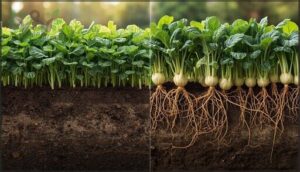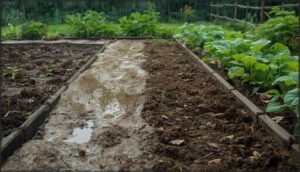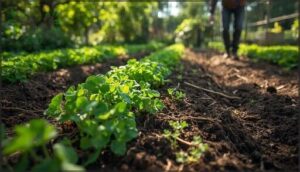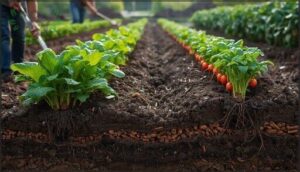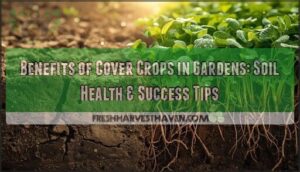This site is supported by our readers. We may earn a commission, at no cost to you, if you purchase through links.

A thriving vegetable garden can turn into a patch of stubborn, slow-growing plants if the soil beneath your feet gets packed tighter than a clay brick. One heavy rain, a few trips across the beds, and suddenly water pools where it should drain, roots twist in frustration, and harvests shrink.
Preventing soil compaction in vegetable gardens isn’t just about avoiding muddy boots—it’s about giving every seed the space to breathe and grow. With a few smart adjustments, you can keep your garden soil loose, healthy, and ready to support strong roots and abundant crops season after season.
Table Of Contents
- Key Takeaways
- What Causes Soil Compaction in Gardens?
- How to Identify Compacted Garden Soil
- Best Practices to Prevent Soil Compaction
- Using Raised Beds to Reduce Compaction
- Role of Organic Matter in Loosening Soil
- Mulching Techniques for Soil Protection
- Planting Cover Crops for Soil Aeration
- Manual and Mechanical Aeration Methods
- Ongoing Garden Soil Maintenance Tips
- Frequently Asked Questions (FAQs)
- Conclusion
Key Takeaways
- Compacted soil restricts root growth, reduces water drainage, and leads to smaller harvests and stressed plants.
- Limiting foot traffic, creating permanent pathways, and timing garden work when soil is dry help prevent compaction.
- Adding organic matter like compost, mulch, and cover crops loosens soil, boosts microbial activity, and improves structure over time.
- Raised beds and regular soil checks support healthy, loose soil, making it easier for roots to thrive and yields to increase.
What Causes Soil Compaction in Gardens?
Soil compaction doesn’t happen by accident—it’s usually the result of specific gardening practices or environmental factors. Understanding what causes your soil to pack down is the first step toward preventing damage to plant roots and soil structure.
Let’s look at the most common culprits that compress soil and reduce its ability to support healthy plant growth.
Over-tilling and Equipment Use
While spring and fall tilling might feel productive, repeated rototilling actually works against you. Each deep pass destroys up to 90% of beneficial fungal networks and creates a plow pan—a hardened layer beneath your tiller’s reach that blocks roots and drainage. Heavy equipment causes subsoil compaction that persists for years, reducing yields by roughly 15% in the first season alone and disrupting the microbial communities essential for healthy soil structure.
Repeated rototilling and heavy equipment destroy beneficial fungi and create hardened soil layers that block roots, drainage, and reduce yields
Reducing tillage intensity can help foster more resilient soil.
Foot Traffic and Pathways
Even lighter foot traffic compresses soil particles, reducing pore space by up to 60% in heavily walked areas. When you repeatedly step through garden beds, bulk density increases, roots struggle to penetrate, and water infiltration drops.
Gravel paths or stepping stones direct movement onto durable pathway materials, creating controlled traffic patterns that limit compaction zones to designated walkways. Pathway design matters—permanent routes allow undisturbed soil recovery in your planting beds.
Heavy equipment worsens this, increasing soil compaction concerns.
Working Soil When Wet
Wet soil risks multiply when you till at the wrong time. Working soil above 30% moisture content—when it won’t crumble in your hand—crushes pore spaces and forms dense clods that resist root penetration. Saturated clay soils reach their plastic limit, making them moldable like clay and vulnerable to lasting compaction.
Tillage timing matters: wait one to three days after rain until soil reaches best field capacity, preventing waterlogging and preserving soil structure.
Soil Type and Natural Processes
Beyond your control over timing and equipment, soil texture plays a powerful role in compaction vulnerability. Clay soils naturally pack denser—often exceeding 1.2–1.3 g/cm³ bulk density—while sandy soil reaches peak compaction risk at just 12–15% moisture. Understanding your soil type helps you work with nature:
- Clay particles arrange tightly, reducing pore space
- Sand compacts easily under foot traffic at the surface
- Freeze-thaw cycles naturally break up shallow compacted layers
- Soil biology builds aggregate stability, strengthening structure against compression
How to Identify Compacted Garden Soil
Before you can fix compacted soil, you need to recognize the warning signs in your garden.
Your soil, plants, and water behavior all offer clues that compaction has taken hold.
Let’s look at the key indicators that tell you it’s time to take action.
Physical Signs in Soil Structure
You can often spot compacted soil just by looking at it closely. Surface crusts up to 2 centimeters thick signal trouble for water infiltration and seedling emergence. You’ll notice large, dense clods resisting breakup, along with poor soil structure shifting from granular to massive.
Look for compaction patterns—linear strips near pathways where bulk density spikes, darker soil bands, or persistent water pooling after rain.
Plant Growth and Root Symptoms
Your plants tell a story when compaction strikes. Stunted growth shows first—vegetables may reach only half their expected height as roots struggle through dense soil layers. Watch for these telltale symptoms:
- Restricted root morphology with 35-65% shorter root length and thicker, twisted structures
- Chlorotic leaves signaling impaired nutrient uptake of nitrogen, phosphorus, and potassium
- Visible water stress including wilting during dry spells
- Yield reduction averaging 15-50% in compacted beds
Water Drainage and Pooling Indicators
Water drainage problems reveal compaction quickly. You’ll notice pooling on the surface lasting more than two hours after rainfall—compacted soils show 30-70% lower infiltration rates than healthy ground. Saturation zones persist up to 48 hours, while runoff volume increases by 200-300%. This waterlogging creates erosion patterns along pathways and beds.
Improving drainage starts with avoiding overwatering and heavy foot traffic, which push soil particles together and reduce the pore space plants need.
Best Practices to Prevent Soil Compaction
The best defense against compacted soil is stopping it before it starts. You can protect your garden’s structure with a few simple habits that keep soil loose and healthy.
Here are three practical ways to prevent compaction in your vegetable beds.
Limiting Foot Traffic and Weight
Every step you take in your vegetable garden presses soil particles together, reducing pore space and harming plant roots. To protect your beds, create designated pathways using mulch or pavers that concentrate foot traffic away from growing areas.
Distribute weight carefully—avoid heavy equipment whenever possible, and if you must use machinery, keep axle load limits below 10 tons. Think of pathways as protective barriers: they preserve soil structure while giving you easy access to tend your plants.
Timing Garden Activities
When you work your garden, soil makes all the difference. Tilling or walking on saturated ground—especially after snowmelt or heavy rain—can destroy soil structure that takes years to rebuild, with over 80% of compaction damage occurring on the first pass over wet soil.
Here’s how to time your garden activities:
- Test soil moisture by squeezing a handful at 4–6 inches deep; it should form a loose ball that crumbles easily, not stick to your shovel
- Schedule spring tillage a few weeks before planting, allowing soil to settle for better seedbed conditions
- Delay major tasks after rainfall or irrigation until soil reaches 70–80% field capacity to minimize compaction
- Start harvest in better-drained areas first, reducing risk in wetter garden sections
- Allow soil recovery between heavy activities to improve aggregate stability and prevent cumulative damage
Waiting even one day for drier conditions in spring greatly reduces compaction risk. Think of timing as insurance: working soil at the right moisture level protects its structure, prevents foot traffic damage, and maintains the pore space your plants need to thrive.
Creating Permanent Pathways
You can redirect up to 90% of foot traffic away from your growing beds by installing permanent pathways. This simple design choice cuts soil compaction by 30% in vegetable gardens and slashes compaction-related plant damage by more than 60%.
Use gravel, crushed granite, or wood chips over landscape fabric—these pathway materials last 10+ years, prevent weeds, and protect raised beds while maintaining soil structure where it matters most.
Using Raised Beds to Reduce Compaction
Raised beds offer one of the smartest solutions for preventing compaction in your vegetable garden. By elevating your planting area and controlling the soil environment, you eliminate many of the pressure points that lead to dense, airless soil.
Let’s look at why raised beds work so well, how to design them for long-term soil health, and what soil mix will give your plants the best foundation.
Benefits of Raised Beds
You’ll find raised beds offer real advantages when preventing soil compaction in your vegetable garden. Here’s what the research shows:
- Yield Increase: Raised beds can boost harvest weight by 33% per square foot compared to in-ground plots, with some crops showing gains exceeding 200%.
- Drainage Improvement: Water moves through 25–33% faster, reducing waterlogging by 40% in heavy soils.
- Climate Adaptation: Soil warms 2–4°C earlier in spring, extending your growing season by three weeks.
- Bed Longevity: Quality materials last 10–50 years with minimal upkeep.
These structures maintain soil retention while improving soil structure naturally.
Design Tips for Optimal Soil Health
Now that you’ve seen the benefits of raised beds, you can amplify those advantages by getting the design right. Keep bed width under 4 feet so you don’t reach across and compress the soil. Orient beds north-south for even sunlight exposure throughout the day.
Layer materials using the Hugelkultur method—woody debris on bottom, compost on top—to boost soil aeration and water drainage. Mulch pathways to guide your steps away from planting zones, preventing soil compaction before it starts.
Choosing The Right Soil Mix
After you’ve laid out your bed design, the fill you choose makes or breaks soil health. A balanced vegetable garden soil mix uses 40% topsoil, 30–40% compost for organic matter content, and 20–30% coconut coir or peat moss to improve water retention. Target an ideal soil pH between 6.0 and 7.0.
Standard soil ratios create the loose soil structure roots crave:
- 40% screened topsoil for mineral foundation
- 35% mature compost boosting organic matter
- 25% perlite or coarse sand for drainage
Specialized mixes suit specific crops, but these proportions give most vegetables the soil texture and soil health they need to thrive.
Role of Organic Matter in Loosening Soil
Organic matter is your best ally for breaking up compacted soil and restoring its natural structure. Think of compost, worm castings, and similar amendments as tiny workers that create air pockets, improve drainage, and feed beneficial microbes.
Let’s look at the practical ways you can use organic matter to loosen your garden soil.
Compost Application Methods
Aged manure and compost are the best types of organic matter for loosening compacted soil.
For new beds, spread 3 to 4 inches of compost and mix it into the top 8 to 12 inches using a spade or garden fork. For established beds, apply 0.25 to 1 inch annually as a surface mulch or lightly incorporate it.
This compost incorporation improves soil structure by increasing porosity and encouraging natural aggregation.
Benefits of Worm Castings
Worm castings stand out as a powerhouse soil amendment for vegetable gardens battling compaction. These nutrient-rich pellets deliver up to 4.3 times more nitrogen and phosphorus than regular soil, while their neutral pH fosters good uptake.
Beyond nutrient enrichment, they improve soil structure by boosting water-stable aggregates up to 58%, increase moisture retention dramatically, introduce beneficial microbes for disease suppression, and even assist with contaminant remediation. You’re basically adding natural insurance for soil health.
Frequency and Depth of Amendments
For vegetable gardens, you’ll want to add 2–3 inches of compost every six months—spring and fall work best. Work amendments 8–12 inches deep to support root growth and soil aeration. Sandy soils need more frequent attention than clay types due to faster nutrient loss.
Long-term trends show that repeated annual applications dramatically reduce soil compaction and boost structure, with benefits compounding most noticeably after three consecutive years of organic matter incorporation.
Mulching Techniques for Soil Protection
Mulch acts as a protective blanket for your garden soil, shielding it from the twin threats of surface hardening and erosion. When applied correctly, organic mulch can reduce surface compaction by 35% within just two growing seasons while maintaining soil moisture levels about 20% higher than bare ground.
Let’s explore the types of mulch that work best, how to apply them properly, and why they’re so effective at keeping your soil loose and healthy.
Types of Organic Mulch
Ever wondered which mulch can transform your vegetable garden’s soil? The best types of organic matter offer more than surface cover—they build resilience from the ground up.
For instance, Straw Mulch suppresses weeds and locks in moisture, while Wood Chips boost microbial activity. Grass Clippings enrich nitrogen, Leaf Mulch improves aeration, and Compost Mulch elevates nutrient availability. Each brings unique benefits to your soil’s health.
- Straw Mulch
- Wood Chips
- Grass Clippings
- Leaf Mulch
- Compost Mulch
Proper Mulch Application
Did you know that mulch depth can make or break your garden’s soil structure? Apply organic mulches two to four inches deep for balanced moisture management and soil temperature control.
Timing matters—wait until plants reach four to six inches tall, and layer mulch evenly without piling against stems.
Mixing old and new mulch improves aeration, letting organic matter work its benefits for soil health and resilience.
Mulch and Moisture Retention
Think of mulch as your garden’s sponge, soaking up rain and locking in moisture. Different mulch types, like straw or bran, boost water absorption and water retention, while moderating soil temperature effects.
This steady moisture underpins nutrient availability and encourages microbial activity, both essential for plant health.
By using organic mulches, you improve soil moisture, conserve water, and create a thriving environment for roots and beneficial organisms.
Planting Cover Crops for Soil Aeration
Cover crops are a simple way to boost soil health and keep compaction in check. They work behind the scenes to loosen hard ground and add valuable nutrients.
Here’s what you need to know before choosing the right ones for your garden.
Best Cover Crops for Vegetable Gardens
Did you know only 7% of U.S. gardens use cover crops, despite their proven impact on soil health?
For your vegetable garden, Legume Benefits come from hairy vetch and crimson clover, boosting nitrogen. Grass Varieties like annual ryegrass break up surface compaction. Brassica Options, such as oilseed radish, drill deep.
Pay attention to Seeding Timing—late summer to early fall is ideal for establishing strong cover crops.
How Cover Crops Improve Soil Structure
When you plant cover crops, their diverse root architecture weaves through compacted layers, boosting aggregate stability and opening channels for water infiltration. Adding organic matter from these crops feeds soil microbes, kicking up microbial activity and supporting healthier soil structure.
For instance, mixed cover crops can lift soil porosity by over 10%, making it easier for roots to spread and your vegetables to thrive.
Timing and Management of Cover Crops
As roots penetrate compacted layers, timing and management make all the difference. You’ll want to match species selection with your planting windows and keep soil contact in mind for strong germination. Watering needs shift with the weather, and termination methods—whether mowing or turning under—shape the benefits. Using cover crops effectively means balancing these factors:
- Choose species for your soil.
- Monitor planting windows.
- Prioritize soil contact.
- Adjust watering needs.
Manual and Mechanical Aeration Methods
When soil gets too dense for roots to breathe, aeration becomes a must. You have several practical options, whether you’re working by hand or tackling a larger space.
Here’s how you can open up your soil for healthier plants.
Manual Aeration Tools and Techniques
A well-chosen hand tool can turn dense, stubborn ground into a welcoming bed for roots. Manual aeration methods—like using plug aerators, broadforks, or the simple “stab and lift” with a hand fork—directly target compacted patches. These Aeration Tool Types, when used on moist soil, boost root growth and water infiltration, though Practical Limitations include labor intensity and core removal challenges.
| Aeration Tool Types | Technique Effectiveness |
|---|---|
| Plug Aerator | Removes 2–4” cores; long-term relief |
| Spike Aerator | Makes holes; less lasting impact |
| Broadfork | Loosens up to 12” deep |
| Hand Fork | Good for small, targeted areas |
| Manual Corer | Suited for under 2,500 sq ft |
Using a Core Aerator in Large Gardens
If manual tools leave you sore, a power-driven core aerator can transform your large garden’s soil structure. Renting one costs about $70 for four hours, but the impact is real—ideal core depth reaches 2–4 inches, lowering soil bulk density and boosting vegetable yield.
Schedule soil aeration every 8–12 months for heavy clay. Consistent aeration improves water infiltration, making compaction less of a headache.
Double Digging for Deep Compaction
Tackling deep soil compaction calls for the double digging approach—a classic technique that transforms compacted soil by loosening layers down to 24 inches.
You’ll notice digging benefits right away: improved water movement, enhanced root growth, and visible density changes. By increasing pore space, double digging boosts soil structure, making it easier for roots to thrive and water to infiltrate.
For persistent compaction, this method’s impact is hard to beat.
Ongoing Garden Soil Maintenance Tips
Keeping your garden soil healthy takes a bit of regular attention. There are a few habits that make a real difference over time.
Here’s what you’ll want to keep in mind as you care for your soil.
Seasonal Soil Checks
Did you know annual garden soil testing can boost your vegetable yield by 15% and cut amendment costs by up to $50? Using composite sampling methods—collecting 10–15 sub-samples—helps you interpret results accurately and track soil compaction over time.
Seasonal soil checks improve soil structure, maintain soil health, and prevent drainage issues, making them a smart investment for long-term garden success.
Adjusting Watering Practices
Although it’s tempting to water often, adjusting your watering frequency is key for healthy soil moisture and water infiltration. For sandy soils, twice-weekly watering helps prevent excessive drying and compaction. Heavier soils benefit from weekly irrigation to maintain drainage and water absorption.
Over-irrigation can degrade structure, so match irrigation timing to your soil type and crop needs. Thoughtful water conservation protects soil drainage and yields.
Avoiding Common Compaction Mistakes
Ever wonder why your garden soil feels like concrete after a rainy week? Small missteps can quickly sabotage soil health. For instance, ignoring pathway planning or tilling too often can harden soil structure. Watch out for these pitfalls:
- Overdoing Tilling Frequency, especially in wet soil
- Neglecting permanent pathways, increasing foot traffic
- Using poor amendment blends, worsening compaction
- Skipping regular monitoring, delaying soil compaction fixes
Frequently Asked Questions (FAQs)
Can soil compaction affect pest and disease levels?
Much like a weakened immune system invites trouble, soil compaction raises pest susceptibility and disease risk by disrupting microorganisms, plant defenses, and nutrient dynamics.
Poor plant and root growth make your garden more vulnerable to these challenges.
How does compaction impact soil temperature regulation?
Soil compaction increases thermal conductivity, so heat moves through the soil faster. Poor soil insulation and lower water content mean soil temperature changes quickly, stressing roots and reducing microbial activity—both essential for soil health and structure.
Are certain vegetables more sensitive to compacted soil?
Certain vegetables, especially shallow-rooted types like lettuce and snap beans, struggle more with soil compaction due to limited root growth and nutrient absorption.
Root system differences, ethylene response variation, and genotypic compaction tolerance all influence plant sensitivity.
Can beneficial insects help reduce soil compaction?
You might think insects just eat plants, but insect tunneling and weed reduction actually boost soil structure.
Their activity drives carbon sequestration, microbial dispersal, and soil genesis, improving soil biology and ecosystem services—directly reducing soil compaction.
What role do earthworms play in preventing compaction?
Earthworms tackle compaction by burrowing through dense soil, creating channels that boost water retention and root growth. Their cast production enriches soil structure, while their activity fosters microbial diversity and nutrient homogenization, improving overall soil health.
Conclusion
Think of your garden soil as a woven basket: each strand—air, water, organic matter—must remain flexible for the basket to hold its shape and strength. Preventing soil compaction in vegetable gardens means tending these strands with care, protecting the spaces between.
When you respect those spaces, roots stretch freely, water moves easily, and harvests flourish. Every step you take, every amendment you add, shapes the foundation that bolsters your garden’s growth for seasons yet to come.
- https://extension.okstate.edu/fact-sheets/raised-bed-gardening.html
- https://www.bitesizedgardening.co.uk/how-to-prevent-soil-compaction-in-garden-allotment-soils/how-to-dig-for-victory/
- https://www.reddit.com/r/gardening/comments/w4xzih/how_do_i_make_my_vegetable_garden_soil_less/
- https://pmc.ncbi.nlm.nih.gov/articles/PMC9102423/
- https://extension.umn.edu/soil-management-and-health/soil-compaction


